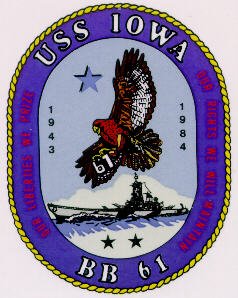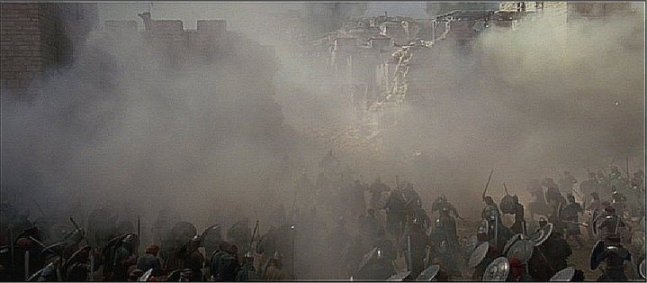USS Iowa Could be Politically Correct Museum

The sickening moon bats of the San Francisco City Government can bring themselves to host a Battleship Museum, it's just too militaristic. Now the organization looking to place the ship in San Francisco's harbor is willing to make the ship a museum to nitwit political correctness, with mixed results.
Last July, San Francisco's county supervisors voted 8-3 against bringing the vintage World War II battleship Iowa to San Francisco as a permanent tourist attraction. Some opponents said they were taking a stand against both the war in Iraq and a military that boots out gays and lesbians, a powerful faction in local politics.
But now, advocates of the move are trying to woo the supervisors with a promise to create a privately funded dockside museum that will tell the story of minorities in the military, including lesbian, gay, bisexual and transgender troops.
"Our feeling was that this would make it a better fit for San Francisco," said Jim Maloney, director of the Military Education Initiative, a group that supports the lifting of restrictions on gays in the military. "Adding in the component of LGBT service would be obviously quite unique," he said.
The new plan also calls for an annual peace symposium on the Iowa, which has a storied record of combat in the South Pacific and off the Korean coast.
Even Sen. Dianne Feinstein has put up a law to let other jurisdictions bid on the ship museum in hopes to pressure the city to accept the offer.
I say this could be an opportunity to use eminent domain to take San Francisco and develop it into an American city.








 BlogHop.com
BlogHop.com







3 Comments:
|Last time I was in SF and bothered to go down to Fishermans Wharf I was pleasantly surprised to find a WWII fleet submarine tied up alongside as a permanent display. Maybe things have changed, or maybe they dont know whats going on in their own backyard.
A military museum that carries information about the history of Don't Ask, Don't Tell and the military is in fact highly appropriate for the Iowa.
A link to my sources is provided at the bottome of the page.
On April 19th, 1989, 47 men died on the USS Iowa when a turret exploded. That was tragedy enough, but what followed was much worse, and a pure example of cover-up and prejudice. It's a shameful episode in the Navy's history. In order to cover its butt, the Navy did the following:
"In May 1989, "unnamed sources" within the Naval Investigative Services (NIS) leaked to NBC correspondent Fred Francis claims that there was evidence of a murder/ suicide involving a "homosexual relationship" between Gunner's Mate Clayton Hartwig (who was killed in the blast) and Gunner's Mate Kendall Truitt (who survived). In June, Francis reported that Navy investigators were "convinced" that Hartwig was a "troubled homosexual" who was suicidal because other sailors had rejected his advances. In both cases the national media picked up the story, with attribution to NBC. In October 1989, the Navy claimed that the blast was "most probably" intentionally caused by Hartwig."
Later however, the Navy was forced to admit it had made the whole story up.
"But that was false, as Thompson discovered. Hartwig was not gay, nor was his friend who died with him in the blast. They had not had a love affair, pleasant or tormented......The sailor's false statement was later retracted, a fact that the Navy also covered up in its zeal to pin blame for the affair on Hartwig. Naval officials even went so far as to conceal the retraction from FBI agents who worked at the agency's behavioral studies unit and who produced a "psychological autopsy" buttressing the detectives' theory. The Navy's coverup also included the suppression of evidence showing that Hartwig couldn't possibly have caused the explosion."
So why did the Navy go to all this trouble?
"Blaming the victim deflected attention from the Navy's own culpability. That culpability included bad maintenance of the 16-inch guns, unsafe working conditions, poor ship leadership and the use of half-century-old gunpowder...."The environment was one notch above hell," Thompson writes. "It was hot, grimy, nasty, hazardous and cramped. The Iowa turret decks were slippery, coated with hydraulic fluid and oil. A tumbling shell could pulverize a man. One misstep in the gun house and a sailor could plunge into the pit, where he might be crushed to death by moving machinery or by an elevating or traversing weapon. Friction and static electricity were constant sources of anxiety. A spark could trigger an explosion."
So this incident, and this ship, are both a part of Navy history, and a part of gay history.
http://www.gryphmon.com/2005/07/boycott_san_fra.html#more
The Iowa has a long and rich history. To take one incident out of it and make it the focus of a museum denigrates that history. Yet even with the willingness to do such the city is still squeemish over a military ship docked in the harbor.
Post a Comment
<< Home